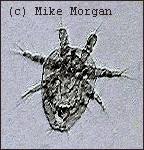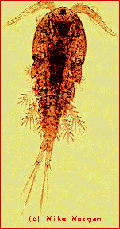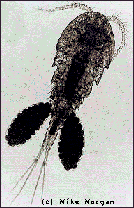CYCLOPS
by Mike Morgan 1996
Overview
Cyclops is a fresh water Arthropod and a member of the Crustacea group, belonging to the
sub-group Cyclopoida and the sub-class Copepoda. There are forty-six free-living species,
of which forty-four belong to the genus Cyclops.
The fused head and thorax is clearly marked off from the abdomen. Typically the head has five pairs of limbs and the mid-body region seven pairs. Their length is ½-3 mm. There is a single median eye near the upper surface of the head.
Origin of name
Cyclops: from Greek mythology 1. Any of the three one-eyed Titans who forged thunderbolts
for Zeus. 2. Any of a race of one-eyed giants, reputedly descended from these Titans,
inhabiting the island of Sicily.
Lifestyle
Cyclops can swim slowly by means of two pairs of antennae or faster with jerks by using
other limbs on the thorax. It seizes food particles with the limbs round the mouth and can
apparently live on the dead bodies of other animals, but very little is known about its
method of feeding. Widely distributed and found in any type of still water all over
Britain. They may also be very common in slow rivers and canals, particularly among weeds.
If you collect a large number of Cyclops and keep them in a small jar of water in which
they were found, and then you examine samples of the water carefully, you will very likely
find all stages in the life-history.
Young cyclops
When the eggs hatch the animals emerging do not resemble the parents very closely, being
smaller, broader in proportion, have only a few pairs of limbs and possess no 'tail-end'
to their body.
 Infants are the Nauplius larvae. The nauplii go through a series of moults,
up to six in number. At each stage the skin is shed, the animals increase in size and they
show more of the adult characters. After these moults they reach the first 'copepodid'
stage and after about five further moults they become exactly like their parents. The time
taken for a Nauplius to develop into an adult varies with the temperature of the water; in
some it is from twenty-two to twenty-six days.
Infants are the Nauplius larvae. The nauplii go through a series of moults,
up to six in number. At each stage the skin is shed, the animals increase in size and they
show more of the adult characters. After these moults they reach the first 'copepodid'
stage and after about five further moults they become exactly like their parents. The time
taken for a Nauplius to develop into an adult varies with the temperature of the water; in
some it is from twenty-two to twenty-six days.
The male
 Male
copepods are, as a rule, smaller than the females. Their first pair of antennae, or at
least one of the antennae, is curiously jointed so that they can catch hold of the female
by curling one antenna round the end of her abdomen.
Male
copepods are, as a rule, smaller than the females. Their first pair of antennae, or at
least one of the antennae, is curiously jointed so that they can catch hold of the female
by curling one antenna round the end of her abdomen.
The female
The female carries two egg-sacs and is easily recognised with the naked eye if egg- sacs
are present. The sacs resemble 'paddles' as can be seen here in this typical image of a
female.
Acknowlegments:
Animal Life in Fresh Water by Helen Mellanby, 6th. Edition pp 96-102. Published by Chapman
& Hall 1963.
By Mike Morgan
Our special thanks and appreciation to Chapman & Hall for permission to reprint text from this work.
Microscopy UK Front Page
Micscape Magazine
Article Library
© Microscopy UK or their contributors.
Please report any Web problems or
offer general comments to the Micscape Editor,
via the contact on current Micscape Index.
Micscape is the on-line monthly
magazine of the Microscopy UK web
site at Microscopy-UK
